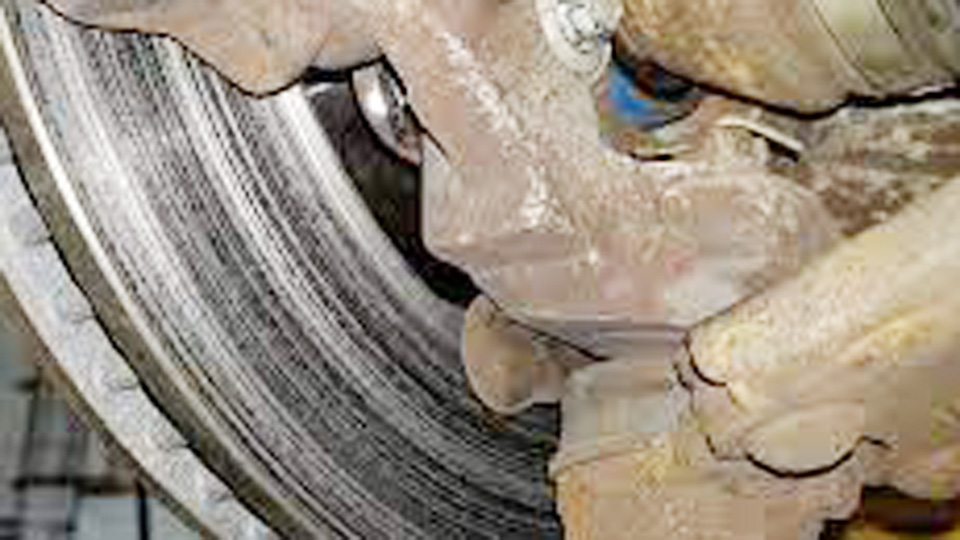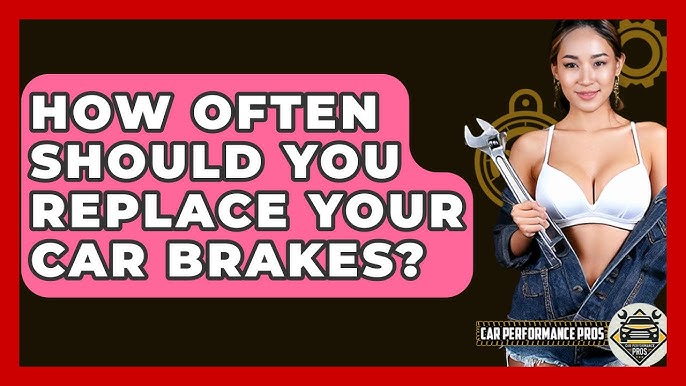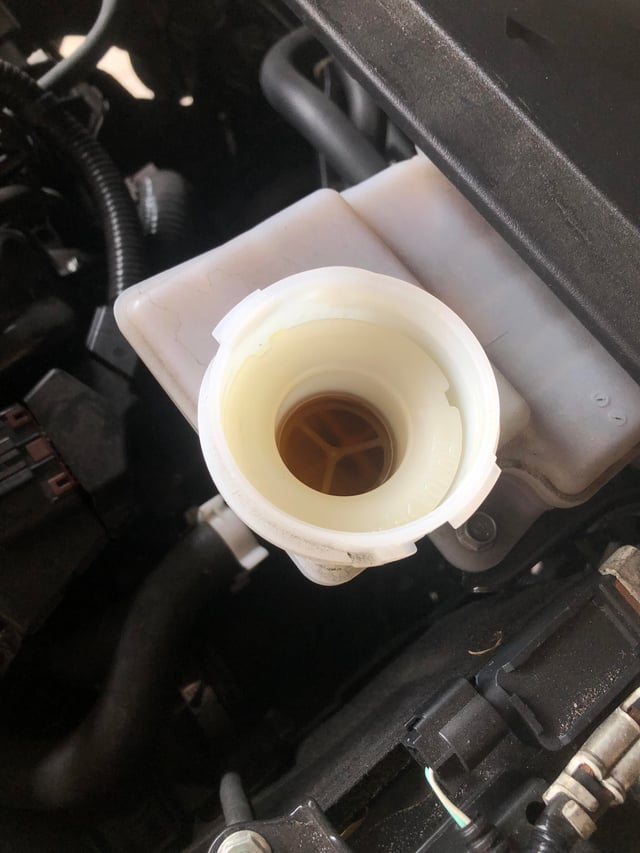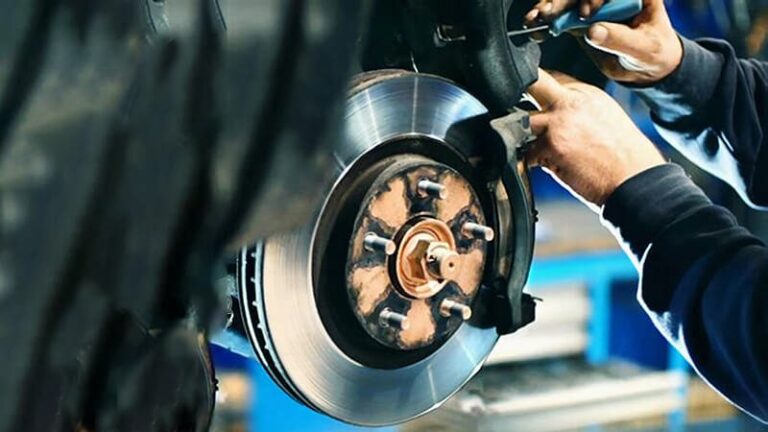I can’t tell you how many times someone has pulled into my garage and said, “Why my car makes a noise when I brake?” It’s one of those issues nearly every driver faces sooner or later, and it usually catches you off guard — a squeal at a stoplight, a grinding sound when slowing down, or even a faint rattle you can’t quite place. In most cases, that noise points to worn or faulty brake parts like pads, rotors, or calipers. These components aren’t just there to stop the car; they’re the difference between a safe drive and a dangerous one.
I’ve replaced countless sets of brake pads for folks who waited too long, and the cost of ignoring it always ends up higher than fixing it early. Once you know what the sound is telling you, you can tackle the problem before it gets worse.

Image by hometowneautorepairandtireofwoodbridge
Common Brake Noises and What They Mean
When your car starts chatting back at you during stops, the type of noise gives big clues. I’ve diagnosed hundreds of these, from family sedans to lifted trucks, and it’s rarely just one thing.
That high-pitched squeal? It’s usually brake pads wearing thin. The pads have a built-in wear indicator – a little metal tab that rubs against the rotor when they’re low. It’s designed to annoy you into action before things get dangerous.
A grinding or scraping sound hits different. That’s often metal-on-metal contact, meaning your pads are shot and now chewing into the rotors. I remember a guy’s Chevy Silverado coming in with this – he ignored the squeal for weeks, and we ended up resurfacing rotors that could’ve been saved.
Then there’s a rumbling or vibration noise. Could be warped rotors or uneven wear. On older Fords I’ve worked on, this shows up after heavy towing without proper cooling.
Brake Pads: The First Line of Defense Against Noisy Stops
Brake pads are those friction materials sandwiched between the caliper and rotor. They create the stopping power by clamping down and slowing the wheel. Without them, you’d be skating through intersections.
Common problems? They wear out over time – typically 30,000 to 70,000 miles, depending on your driving. City stop-and-go eats them faster than highway cruising. Signs of failure include that telltale squeal, reduced stopping power, or even a burning smell if they’re overheating.
You need to replace pads when they’re down to about 3mm thick. I’ve pulled pads off Toyotas that were paper-thin, and the owner was shocked at how spongy the pedal felt. Don’t wait – thin pads overwork the rest of the system.
OEM pads from brands like Genuine GM or Ford Motorcraft are pricier but fit perfectly and match your car’s specs. Aftermarket options from ACDelco, Bosch, or Wagner can save 20-50% and often perform just as well, especially their ceramic lines for less dust.
Installation tips: Jack up the car safely – use stands, not just the jack. Loosen the caliper bolts, slide it off, and pop out the old pads. Clean the clips and apply anti-squeal compound to the backs of the new ones. Common mistake? Forgetting to bed them in – drive gently for the first 200 miles to avoid glazing.
From my shop days, I once swapped pads on a Honda Civic where the owner used cheap no-name parts. They squealed worse than before. Lesson: Stick to reputable brands.
Brake Rotors: Why They’re Often the Hidden Culprit in Grinding Noises
Rotors are the spinning discs your pads grab onto. They dissipate heat and provide a smooth surface for friction. In US vehicles like Jeeps or Rams, they’re vented for better cooling.
Issues arise from warping due to heat cycles or corrosion in salty winter states. Signs: Pulsing pedal or that grinding when braking. I’ve seen rotors on Subarus rust solid after sitting unused.
Replace when they’re scored, warped beyond 0.002 inches, or below minimum thickness (stamped on the rotor). For a typical sedan, that’s around 20mm.
OEM rotors from Mopar or Honda are reliable but cost $50-100 each. Aftermarket like PowerStop or Centric offer drilled/slotted versions for better performance, often under $40, but they can wear pads faster.
To install: Remove the wheel, caliper, and bracket. Tap the rotor off with a hammer if stuck – gently, to avoid damage. Torque the new one to spec, usually 80-100 ft-lbs. Mistake to avoid: Overtightening lug nuts unevenly, which warps the new rotor right away.
I had a customer with a grinding Dodge Charger. Turned out the rotors were aftermarket knockoffs that warped in months. Always check for DOT stamps to spot fakes.
Brake Calipers: When Sticking Leads to Uneven Wear and Noises
Calipers house the pistons that push pads against rotors. They’re hydraulic wonders, but seals fail over time.
Problems: Sticking pistons cause dragging, leading to squeaks or groans. Fluid leaks or corrosion in humid areas like Florida are common.
Replace if they’re seized or leaking – don’t rebuild unless you’re experienced, as it’s finicky. For a Ford F-150, calipers last 100,000 miles typically.
OEM from brands like TRW (common in GMs) ensure compatibility. Aftermarket Raybestos or Cardone remanufactured ones are budget-friendly, around $30-60 vs $100+ OEM, but check warranties.
Installation: Bleed the lines first – use a bleeder kit to avoid air bubbles. Bolt on the new caliper, torque to 25-35 ft-lbs. Safety tip: Wear gloves; brake fluid eats paint.
In my experience, a seized caliper on a VW Jetta caused uneven pad wear and constant noise. Swapping it fixed the issue, but the owner learned to flush fluid every two years.
Brake Shoes and Drums: For Older or Rear Brake Setups
Not all cars use discs all around – many sedans and trucks have drum brakes in the rear. Shoes are the curved friction pieces inside the drum.
They arc out to press against the drum for stopping. Less common now, but vital on classics or base models.
Failure signs: Squealing from glazing or a deep groan if adjusted wrong. Drums crack from overheating.
Replace shoes at 1/8 inch lining left, drums if scored beyond resurface limits.
OEM from ACDelco for Chevys are spot-on. Aftermarket Bendix or Monroe save cash and include hardware kits.
Adjust the star wheel during install for proper drag. Common error: Forgetting the parking brake cable adjustment, leading to weak e-brake.
Worked on a ’90s Toyota pickup with drum groan – shoes were original! Fresh set quieted it right up.
Brake Lines and Hoses: The Silent Contributors to Noisy Brakes
These carry fluid from master cylinder to calipers. Steel lines rust, rubber hoses crack.
Bulging hoses cause spongy pedals and odd noises from pressure issues.
Replace hoses every 60,000 miles or if cracked. Lines if rusted through.
OEM hoses from Gates or Continental fit best. Aftermarket Dorman are widely available at AutoZone for $10-20.
Flare nuts carefully during install – use a line wrench to avoid stripping. Bleed thoroughly.
A burst line on a highway once – scary story from a client. Preventive swaps are key.
How to Diagnose Brake Noises Yourself
Grab a flashlight and jack stands. Inspect pads through the wheel – if thin, that’s your squeal.
Test drive: Note when noise happens – light braking? Heavy? Turning?
Use a mechanic’s stethoscope for pinpointing.
If unsure, visit a shop – better safe.
OEM vs Aftermarket Brake Parts: A Side-by-Side Comparison
Let’s table this out for clarity:
| Aspect | OEM Parts | Aftermarket Parts |
|---|---|---|
| Fit & Compatibility | Perfect match to your vehicle model | Good, but check specs; some universal |
| Price Range (per pad set) | $50-150 (e.g., Genuine Toyota) | $20-80 (e.g., Ceramic Hawk) |
| Durability | High, factory-tested | Varies; premium like EBC last long |
| Warranty | Often 12-24 months | 6-36 months, brand-dependent |
| Performance | Consistent, as designed | Can upgrade (e.g., slotted for heat) |
| Availability | Dealerships, online OEM sites | Parts stores like O’Reilly, Amazon |
Pros of OEM: No surprises, great for warranties. Cons: Costly.
Aftermarket pros: Affordable, options for performance. Cons: Quality varies – avoid generics.
For a Honda Accord in the US, I’d go aftermarket Bosch for daily driving.
Spotting Genuine vs Fake Brake Parts
Fakes flood online markets. Genuine have holograms or serials – check manufacturer sites.
Packaging: OEM in branded boxes, not plain.
Price too low? Suspect. Buy from trusted like NAPA or RockAuto.
A fake pad set I saw melted under heat – dangerous!
Tools and Safety for Brake Jobs
Essentials: Jack, stands, lug wrench, C-clamps, brake cleaner.
Safety: Chock wheels, wear eye protection, dispose fluid properly.
Pro tip: Use a torque wrench – under-torqued bolts fail.
Maintenance to Prevent Future Noises
Flush fluid every 2 years – DOT 3 or 4 for most US cars.
Clean calipers annually.
Drive style: Avoid hard stops to extend life.
Anecdotes from the Garage
Remember that Subaru Outback with a mystery squeal? Turned out dust buildup – simple clean fixed it, no parts needed.
Or the fleet of Ubers I serviced – pads wore twice as fast from constant city braking. Taught owners to anticipate stops.
Common question: “Can I mix brands?” Sure, but match materials for even wear.
Step-by-Step Guide to Replacing Brake Pads and Rotors
- Park on level ground, chock rear wheels if front job.
- Loosen lugs, jack up, remove wheel.
- Remove caliper bolts (usually 12-14mm), hang with wire – don’t strain hose.
- Slide out old pads, compress piston with C-clamp.
- If rotors: Remove bracket bolts (17-19mm), pull rotor.
- Install new rotor, grease hub.
- Insert new pads with shims, reassemble caliper.
- Pump pedal to seat, test drive.
Takes 1-2 hours per axle for DIYers.
Pros and Cons of Ceramic vs Semi-Metallic Pads
Ceramic: Quiet, low dust, last longer. Cons: Pricier, less bite in cold.
Semi-metallic: Great stopping, affordable. Cons: Noisier, more dust.
For snowy Michigan, I prefer semi-metallic for grip.
US-Specific Brake Part Availability and Compatibility
In the States, AutoZone, Advance Auto stock most. For exotics like BMW, try ECS Tuning.
Check compatibility with VIN – sites like PartsGeek help.
Ford parts easy at dealers, imports like Nissan order online.
Conclusion
Wrapping this up, understanding why your car makes a noise when braking boils down to wear on pads, rotors, or other components. Prioritize safety – get it checked pronto. When buying, weigh OEM reliability against aftermarket savings, and always verify genuineness. Smarter decisions come from hands-on inspection and quality parts. After any brake work, bed in the parts with progressive stops from 30 mph – it’ll ensure quiet, effective braking for miles.
FAQ
What Causes Squeaking Brakes After Rain?
Moisture can cause temporary squeaks as it evaporates. If persistent, check for glazed pads or rust. Wipe rotors dry and drive gently to clear it.
Grinding Noise When Braking at Low Speeds – Is It Serious?
Yes, often pads worn to the backing plate grinding on rotors. Inspect immediately – driving like this damages rotors fast and compromises stopping.
How Long Do Brake Pads Last on a SUV?
Typically 40,000-60,000 miles, shorter with towing or hills. Factors like Akebono pads on a Jeep can extend it.
Can Bad Brake Fluid Cause Noises?
Indirectly, yes – contaminated fluid leads to caliper issues and dragging noises. Flush every 24 months with fresh DOT-rated fluid.
Why Do My Brakes Make a Clicking Noise When Stopping?
Could be loose caliper hardware or worn clips. Tighten or replace – I’ve fixed many with a $5 hardware kit.
(Word count: 2,856)



